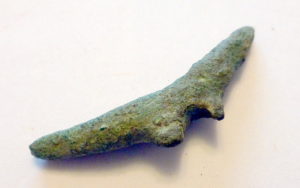
Miscellany Gallery

Miscellany Gallery
All the items shown in this gallery were found in Martham over the past 50 years by a small number of dedicated metal detector enthusiasts. Please don’t think there are easy pickings in the area. The contributors have spent many hundreds of hours field walking scattered fields to make these finds. No hoards have ever been found in Martham.

Bronze Age Mace Head.
A mace is a blunt weapon, a type of club that uses a heavy head on the end of a handle to deliver powerful strikes.
Contributor Jean.

Iron Age Terret Ring.
Terret rings were attached to chariots, carts or wagons and served as rein-guides.
Contributor Jean.

Iron Age Woad Grinder.
A grinder was used to pulverise vegetable material such as woad in the preparation of dyes.
Contributor Jean.


Iron Age terret ring with a Celtic Boar design. Contributor Jean.

This Iron Age or Romano-British ferrule mount probably adorned harness or furniture.
It is a solid cast head of a bull or cow with ears, horns and prominent oval eyes.
It has a curving socketed neck that splays to a broad mouth and there are four rivet holes evenly spaced around the outer edge.
It is 47mm in length.
Contributor A.
A portion of a Roman ceramic tile. Probably from a flue. The pattern on the exterior is there to provide a key for subsequent plastering. Mid 1st to 4th century.
Contributor A.




Roman Saddle Quern
Saddle querns are generally roughly cylindrical and used with both hands, or rough hemispheres and used with one hand. This provides for a forward and back motion suitable for crushing malted grain.
Contributor A.



Lead weight in the shape of a shield. 12th/13th century.
Found in November 2023.
The finder wishes to remain anonymous.

Heraldic Pendants

Shield shaped Medieval heraldic pendant.

This shield shaped pendant is worn but is thought to show the Coat of Arms of the 3rd Earl of Derby, Henry Bolingbroke (1367–1413).
He became King Henry IV in 1399.
Found in August 2023.
The finder of both the above wishes to remain anonymous.
These small heraldic ornaments, now perhaps more correctly called armorial pendants, came into popular use during the latter part of the 14th century. Although it has long been thought they were suspended by their loop to leather as some sort of horse trapping or adornment this has now been questioned. Numerous contemporary illustrations show no sign of them on horses. Searches of seals, monumental effigies, brasses and illustrations of knights in armour also fail to show illustrations of them. This would tend to suggest that these pendants were probably used more in the nature of badges for retainers, messengers or other representatives of noblemen, rather than by nobility themselves. Although many, like this example, are found in poor condition they are nevertheless of considerable interest to those interested in heraldry and are a credit to the craftsmanship of that period.

Medieval bronze sword pommel, circa 1300-1400 AD. A medieval polyhedral shape sword pommel, flat on each face and at each end a rectangular hole for receiving the iron tang of the sword. Ward-Perkings type VIII, Oakshot (1998) type I1.
Found in 2024. The finder wishes to remain anonymous.
Below is a late medieval, c1400, cast copper sword pommel found in Martham in 2023.
It has a hooded face or animal design.
Contributor A.

Bronze figure from a cross, with traces of surface gilding. It shows the Madonna with long robe falling into folds below her waist and draped head and outer garments covering the back. Her left arm is bent at the elbow with her palm facing forward. Her right arm is similarly bent with her hand clutching (a book?). The base of the figure tapers to where it was broken from the branch of a cross. Dated to late 15th century and found in a field in the Cess area of Martham. Size 900mm high.
Displayed with the kind permission of the Norfolk Museums Collection. Ref Number GRYEH : 1978.24


This rather unusual find of a Georgian/Victorian bosun’s whistle was found in the village in 2024.
This decorative lead model of a chair was found in 2024. Use unknown.
